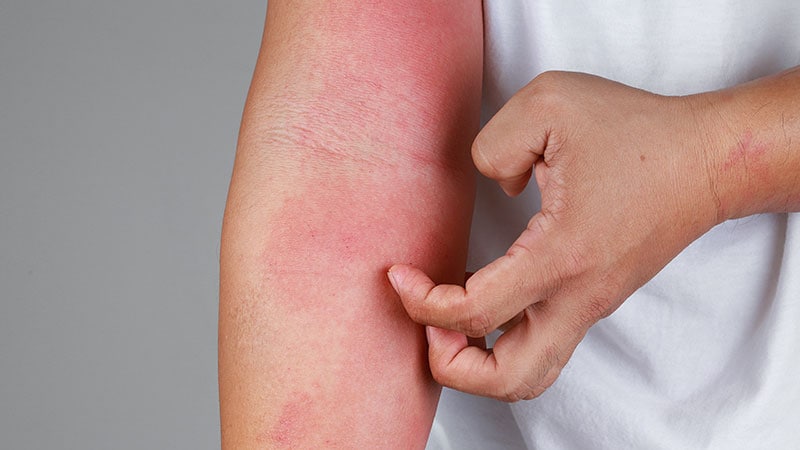The American Academy of Dermatology (AAD) recently issued a focused update to its guidelines on the management of atopic dermatitis (AD) in adults, strongly recommending four recently approved therapies: tapinarof cream, roflumilast cream, lebrikizumab, and nemolizumab (in combination with topical therapy). These additions reflect high-certainty evidence supporting both efficacy and safety, according to the workgroup’s systematic review published in the Journal of the American Academy of Dermatology.
Asked to comment on the updates, one of the authors, Robert Sidbury, MD, cochair of the guideline committee and chief of dermatology at Seattle Children’s Hospital, Seattle, called the rapid need for a guideline update “a reflection of the extraordinary progress in AD care that is ongoing and is indeed revolutionizing care.” Having “two new nonsteroidal topical therapies is quite significant,” he added in an interview with Medscape Dermatology. “Patients have long been dissatisfied with topical options, which have been shackled by safety concerns, some real, some not, and intolerance, such as application site stinging.”
The update comes just over a year after the release of AAD’s 2023-2024 adult AD guidelines on treatment with topical and systemic therapies, underscoring the rapid pace of therapeutic development for AD. The update was initiated following the FDA approval of multiple new therapies and newly published high-certainty evidence supporting their use, prompting the AAD to incorporate this data into its existing guidance, according to the authors.
Strong Recommendations for Four New Agents
The guideline workgroup applied the GRADE (Grading of Recommendations Assessment, Development, and Evaluation) framework to assess new data and formulate treatment recommendations. According to the authors, all four therapies received “strong” recommendations based on high-certainty evidence:
- Tapinarof cream 1%: A nonsteroidal aryl hydrocarbon receptor agonist approved in 2024 for moderate to severe AD. In four trials (n = 1169), once-daily use over 8-12 weeks resulted in statistically and clinically significant improvements in investigator’s global assessment (IGA), eczema area and severity index (EASI)-75, and itch scores.
- Roflumilast cream 0.15%: A phosphodiesterase-4 inhibitor approved in 2024 for mild to moderate AD. Clinical trials (n = 1427) demonstrated significant improvements in IGA and EASI-75 after 4 weeks.
- Lebrikizumab: An interleukin (IL)-13-targeting monoclonal antibody approved in 2024 for moderate to severe AD. In over 1700 patients, treatment with or without topical corticosteroids led to marked improvements in clinical and patient-reported outcomes.
- Nemolizumab (with topical therapy): An IL-31 receptor inhibitor approved in 2024 for patients aged 12 years or older inadequately controlled with topical therapies. In three trials (n = 1256), nemolizumab plus topical corticosteroids (with or without topical calcineurin inhibitor) led to significant reductions in itch and improvements in EASI-75 and Dermatology Life Quality Index.
Updated Treatment Algorithm
The guideline includes an updated treatment algorithm to help clinicians integrate these agents into clinical practice. It emphasizes:
- Baseline management: Includes moisturizers, bathing routines, and avoidance of triggers.
- Escalation pathway: Incorporates new topical agents (tapinarof, roflumilast) and biologics (lebrikizumab, nemolizumab) into moderate to severe disease treatment steps.
- Systemic options: Biologics, JAK inhibitors, and immunosuppressants remain key choices for refractory disease.
All four newly recommended therapies are indicated with strong recommendation symbols in the updated algorithm figure.
Real-World Considerations
Sidbury emphasized that having multiple high-certainty options creates new opportunities but also new challenges in decision-making. “Such choice is a lovely problem to have,” he said, but he urged clinicians to look beyond efficacy. For example, “a patient with baseline ocular difficulties would want to be aware that IL-4/13 or IL-13 biologics can cause or exacerbate conjunctivitis,” he explained. “Nemolizumab or a JAK inhibitor, neither of which carries ocular risk, might be a good choice. Similarly, patients with cardiovascular risk may want to avoid JAK inhibitors due to their boxed warning.”
Treatment selection, he said, should be rooted in shared decision-making: “It’s important to weigh evidence alongside a patient’s comorbidities, preferences, and tolerability history.”
Remaining Gaps and Considerations
Despite the promising data, the authors acknowledged important limitations. Most trials were short-term (≤ 24 weeks), and the long-term safety, durability of response, and comparative effectiveness of these agents remain unknown.
Cost is another factor. The authors noted, “costs for the considered therapies may be prohibitive without adequate insurance coverage.” As such, they stressed the importance of a shared decision-making process that weighs efficacy, safety, and affordability.
Clinical Impact and Future Directions
The update is expected to have an immediate impact in clinical settings. “Atopic dermatitis care has long been an ‘off-label’ affair,” Sidbury said. “Prior to 2017, the only FDA-approved systemic therapy for AD was systemic steroids. Since then, we’ve seen numerous novel topical and systemic therapies approved with many more on the way. Better evidence plus more choices equals improved outcomes.”
Still, more research is needed. Sidbury pointed to the importance of identifying which therapies may work best for specific patient subtypes — by age, race, gender, or AD phenotype. “We don’t know yet, but the answer is likely yes. This gets at personalized medicine — and that’s where we’re headed,” he said, noting that future treatment may be guided by inflammatory signatures or genotyping.
While this focused update offers valuable clarity on incorporating new treatment options for adult AD, further research is needed, according to the authors. The workgroup called for real-world data, head-to-head trials, and longer-term outcome studies. The authors also noted pediatric guideline updates are expected in a future publication.
This study was funded in total by internal funds from the American Academy of Dermatology. Sidbury disclosed he serves as an advisory board member for Pfizer, receiving honoraria; as a principal investigator for Regeneron, receiving grants and research funding; as an investigator for Brickell Biotech, and Galderma USA, receiving grants and research funding; and as a consultant for Galderma Global and Microes, receiving fees or no compensation. Other authors reported having financial disclosures with many pharmaceutical companies.
Source link : https://www.medscape.com/viewarticle/aad-issues-recommendations-four-new-therapies-adult-atopic-2025a1000h8s?src=rss
Author :
Publish date : 2025-06-27 06:46:00
Copyright for syndicated content belongs to the linked Source.
